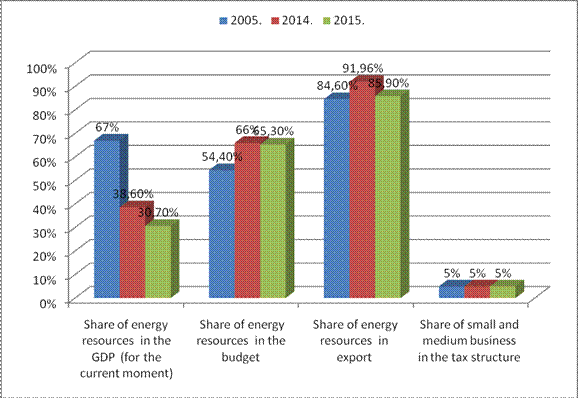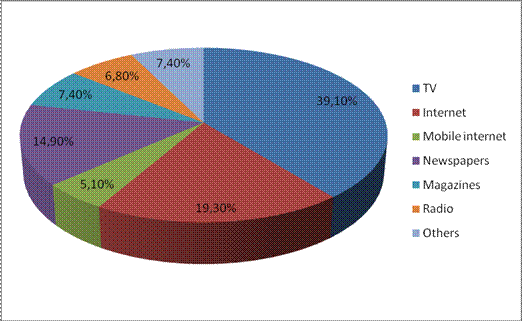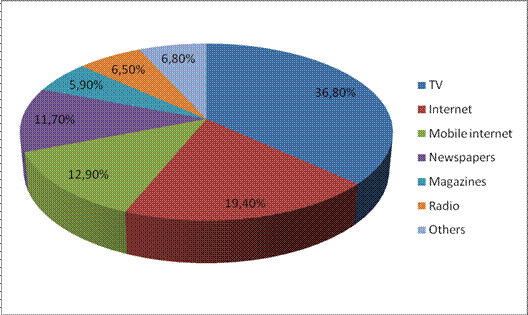
Kolaj
By the 141th anniversary of the Azerbaijani press
In 2015 the economic situation of the media in Azerbaijan deteriorated further due to the devaluation of the manat and fall in economic activity. In a word, the country has entered a period of crisis followed by the media crisis.
In Azerbaijan, according to the State Statistics Committee, in 2015 the total turnover of the main source of media revenue - advertising market fell by 13.3%, and amounted to 62, 8 million manat ($60 million) instead of 72, 5 million manats ($93 million) a year earlier. In dollar terms, the market fell by 35%.
The volume of media advertising amounted to about 26 million AZN ($24.7 million.) Although in manat terms it grew by 3%, but the drop in dollar terms amounted to 22.8%.
The volume of media advertising in thousands AZN
| 2014 | 2015 | Dynamics % в $ | |
| Total | 25 128 ($32 million) | 25 969,1 ($24 732) | -22,8% |
| TV | 22 665,9 ($28,9 million) | 19 836,0 ($18 891) | -31,4% |
| Radio | 1 376 ($1,7 million) | 3 094,3 ($2 946,9) | -+41% |
| Internet | 775,2 ($993,000) | 1 565,6 ($1491) | +33% |
| Newspapers and magazines | 244 ($312,000) | 1 408,7 ($1341) | +77,8% |
Radio and television broadcasting, which includes 10 central TV channels is fully controlled by the authorities, and the received funds in the range of $22.9 million ($28.9 million in 2014) ensure certain existence, but small income severely restrain their development.
The data of the volume of advertising the printed and online media $2.9 million ($1.08 million in 2014) indicate their commercial failure and complete independence from external funding. Statistics show more than four times the growth of advertising in the print media. However, this was due to the influx of advertisement in magazines such as glamour magazines "Baku", which head the president's family members.
In Azerbaijan there are about 300 actual print and online media. On average, each of these media accounts for $8.500 a year, or $708 per month. Of course most of them do not receive advertisement, a small number has up to several tens of thousands per year, which is not enough for the maintenance of huge states and irregular salaries for one month.
An indicator of the economically prosperous and free media development, as well as a free economy is an accepted world norm of media advertisement volume in the country's GDP, which should be more than 1%.
Until the next global economic crisis that began in 2008, this ratio was present in almost all countries with a free economy. The balance broken in the subsequent years of crisis, but the fall did not exceed 50% in 2015. The exception is the US, where the golden ratio of 1% to GDP was achieved.
The ratio of volume of the media advertisement of Azerbaijan GDP ($ 51.7 billion) amounted to 0.047%. This is slightly more than in 2014, when the figure was equal to 0.034%. This is considerably less than in 2005, when the figure was 0.14%. At that time, according to Turan research, the market volume amounted to $ 25 million with GDP $19.9 billion.
Circulation and other problems
Circulations of newspapers and magazines have decreased, and the maximum retail sales volume is 2,000 copies a day. This is by three or four times less than it was five years earlier. The circulation of periodicals, which is distributed by subscription is much higher, but this is due to the protectionism of the state - budget organizations are forced to subscribe to state and pro-government newspapers and magazines.
Another decline in retail sail of periodicals, which generally started at the end of the 90s after the state banned the sale of printed materials in the subway, on the streets, as well as limiting their sales in kiosks. The number of kiosks continued to decline. Under the European standard one kiosk is intended for 1.5 people, but in Azerbaijan one kiosk is intended for 17.000people. Another problem is that because of the lack of advertising the newspapers have to survive at the expense of circulation sales. In this regard, the prices for the last three years have increased, and amounted to AZN 0.60 per copy. It is expensive and discourages potential readers.
Low incomes have a serious impact on the quality of the products - the low professional level of articles, information that also repels readers. Another problem is the poor printing quality. Only state newspapers in the country are published colorful, and the rest periodicals are published in black and white format.
Reduced of circulation cannot be linked to the development of the Internet. The experience of the neighboring countries, Georgia and Armenia, and in Western countries shows that newspapers remain profitable and attractive area for advertising. Circulation of the Georgian newspaper Kviris palitra is 30,000; Alia -. 12,000, Sitkva isaqme -. 10,000, Rezonansi - 7,000 copies a day.. Advertising takes up 50% of newspaper space. In Armenia, the most popular are private newspapers Haykakan Zhamanak, Aravot, 168 Zham and Iravunk. Azg daily and Yerkir. Their daily circulation varies between a few thousand, and do not exceed 8,000 copies.
In the civilized world then transition of readers from print to electronic versions is taking place in an evolutionary way, and, in any case, makes it possible to change the media as an evolutionary form of its publication.
Objective and subjective reasons for the negative dynamics of the economic situation of the media
Objective reasons include:
1. Crisis of economy. The fall in GDP in dollar terms by 29.5%.
2.Unbalanced development:
| 2005 | 2014 | 2015 | |
| Share of energy resources in the GDP (for the current moment) | 67% | 38,6% | 30,7% |
| Share of energy resources in the budget | 54,4% | 66% | 65,3% |
| Share of energy resources in export | 84,6% | 91,96% | 85,9% |
| Share of small and medium business in the tax structure | 5% | 5% | 5% |

The next objective obstacle is the huge layer of illegal economy, monopoly in the non-oil sector, weak, small and middle-class of producers of goods and services.
Subjective reasons include deliberate economic strangulation of the state media by blocking the receipt of income from advertising. Advertisers are subjected to pressure in order to prevent advertising in the independent and opposition media. As a result, independent media virtually ceased to exist as an institution.
Approximately 34 newspaper were officially funded in the range of 2.6 million AZN on the line of the State Support Fund for Media Development under the Azerbaijani President. But the lion's share, or the underwater part of an iceberg of the state illegal funding could be tens of millions dollars. As a result of the economic dependence the media continues to be an instrument of propaganda, and do not carry any more the function, which is dictated by the media law and Professional Code of Ethics of the journalist, the key point of which is the Principle 1. Serving the truth, accuracy and objectivity.
Conclusions and forecast from the previous article (July 2015) are applicable to apply to this study in connection with the extension of the media crisis:
"While it is possible to predict that the media advertising market will remain within the normal range the past 10 years, because this is the political and economic phenomenon. Developed media advertising market is an integral part of a free and liberal economy, which does not refer to the economy of Azerbaijan. Formation of media advertising market in accordance with international standards is possible only with high economic freedom, fair and highly competitive producers of goods and services, especially for small and medium-sized businesses, the engine of the economy. And this is impossible without the creation of a democratic system of government, one of the institutions of which is an independent media. The current regime in Azerbaijan is not ready for changes and will maximum seek to the preservation of the status quo. "
Market of Global Media Ads
The global advertising market continued upward trend. According to the new forecast of the ZenithOptimedia communication network, the global advertising market grew by 4.4%, and reached $ 554 billion. In 2016 is expected growth by 5.3% .
Global investment in the mobile Internet advertising in 2016 will exceed the cost of publication in the press. This media will take a share in 12.4% of global spending on advertising. Newspapers share will drop to 11.9%, predicts ZenithOptimedia. Mobile will become the third largest investment advertising medium, after television and desktop-internet. The development of the mobile Internet continues to be the main driver of growth in the global advertising investment. Its share in the growth of the global advertising market will be 83% in the period from 2014 to 2017. In 2018, the Internet will surpass TV, and will become the world's first media-sized advertising investment.
According to the research by the agency in 2014, media advertising market was divided between:
| TV | 39,1% |
| Internet | 19,3% |
| Mobile internet | 5,1% |
| Newspapers | 14,9% |
| Magazines | 7,4% |
| Radio | 6,8% |
| Total | 92,6% |

On the results of the 2017 the global ads market will increase and reach $581 billion., где and media market will occupy 93% or $541,6billion:
| TV | 36,8% |
| Internet | 19,4% |
| Movile internet | 12,9% |
| Newspapers | 11,7% |
| Magazines | 5,9% |
| Radio | 6,5% |
| Total | 93,2% |

It means that over 2015-2017 years the media-market will increase by approximately 14%.
According to the agency, top ten advertising markets include:
| Countries | Volume in billion/$ | to GDP |
| USA | 176,2 | 1,05% |
| China | 45,7 | 0,50% |
| Japan | 41,5 | 0,84% |
| Germany | 24,7 | 0,66% |
| Great Britain | 24,3 | 0,90% |
| Brazil | 14,2 | 0,63% |
| France | 13,7 | 0,46% |
| South Korea | 11,8 | 0,90% |
| Australia | 11,5 | 0,74% |
| Canada | 10,3 | 0,56% |
Turan Analytical Service





































Leave a review